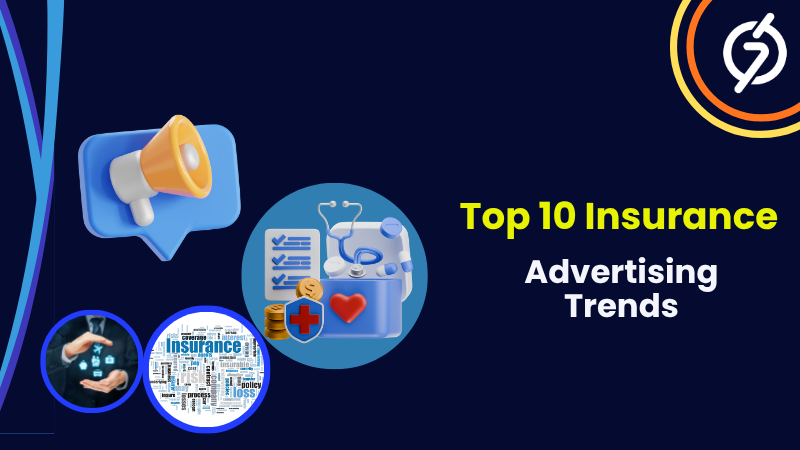Insurance advertising is undergoing a major shift in 2025. What worked a few years ago such as static visuals, broad targeting, and cautious messaging no longer drives engagement or conversions. The industry move toward digital first strategies, coupled with evolving customer expectations, has made relevance and personalization the new battlegrounds for insurance marketers. Whether you are working on insurance advertising, insurance marketing, or insurance promotion, keeping pace with these changes is no longer optional; it is essential for growth.
In this guide, we will uncover the Top 10 Advertising Trends for Insurance Companies in 2025, exploring how each one can help you connect authentically with modern audiences and increase campaign ROI.
1. Hyper Personalization in Every Touchpoint
The era of generic insurance ad campaigns is fading fast. In 2025, customers expect every ad to feel personally relevant from the first banner impression to the final quote request. Hyper personalization powered by data analytics and AI is redefining how insurance advertisers build relationships.
Using customer data like life stage, behavior, and financial intent, advertisers can now predict needs before customers express them. For instance, AI models can detect when someone might be searching for family insurance or travel coverage based on browsing habits.
For a deeper understanding of how to align creative strategy and data driven targeting, explore this Guide to Insurance Advertising For Lead Generation. It is packed with actionable ideas for smarter campaign optimization.
2. First Party Data Becomes the Core Asset
With third party cookies nearly phased out, 2025 marks the full transition to first party data dominance. Insurance companies are investing in owned channels like email newsletters, app usage analytics, and quote request data to power ad personalization.
The pain point here is that many advertisers still rely on fragmented data sources, leading to inconsistent messaging and lower ad efficiency. The solution lies in integrating first party data with ad management tools that can deliver unified insights across platforms.
This trend helps insurers maintain compliance while improving campaign accuracy. It is not just about privacy; it is about ownership of customer relationships.
3. AI Powered Ad Creative Optimization
AI driven automation is transforming how insurance ad creatives are designed, tested, and scaled. Machine learning algorithms can now analyze ad performance in real time, adjusting visuals, CTAs, and copy to align with audience sentiment and engagement rates.
Instead of running A B tests manually, advertisers use AI powered platforms that learn continuously. The mini insight here is that AI does not replace creativity it amplifies it by removing guesswork. The smartest insurance marketers use AI as their creative co pilot to boost click through rates and reduce acquisition costs.
4. Video Ads Dominate Awareness Campaigns
In 2025, short form video remains the most effective medium for storytelling. Insurance is an emotional purchase, and video allows brands to humanize their offers. Authenticity and relatability are key drivers showing real people, real claims, and real support builds trust faster than static images ever could.
A 2024 market study revealed that video based insurance campaigns achieved 45 percent higher engagement compared to display ads. The message is clear: if your brand is not leveraging video yet, you are missing out on massive attention and credibility opportunities.
5. Contextual Advertising Returns Stronger Than Ever
With privacy regulations tightening and cookie tracking fading, contextual advertising has made a powerful comeback. In this trend, insurance ads are placed alongside relevant online content think travel blogs for travel insurance or health news sites for medical coverage.
This approach ensures ads appear where intent already exists boosting both visibility and conversion potential. It is a smart and ethical way to stay visible without invading user privacy.
Advertisers using contextual targeting report 30 percent higher click through rates on average. It is a perfect blend of compliance, intent, and impact.
6. Voice and Audio Ads Gain Traction
Voice search and smart speakers have redefined customer engagement. More people now ask Alexa or Google Assistant for insurance recommendations than ever before. This shift has opened a new lane for insurance advertising voice based and audio driven campaigns.
Imagine an ad where a listener hears, “Looking for better life insurance coverage? Get instant quotes in under 60 seconds.” It is interactive, convenient, and frictionless.
Brands that adapt to voice first environments will enjoy early mover advantages especially as voice commerce continues to grow.
7. Micro Moments Drive Mobile Engagement
Insurance advertisers are learning that success in 2025 depends on showing up during micro moments those brief intent rich instances when people turn to their phones for quick decisions.
Whether it is best car insurance in my city or affordable health plans these moments are where high intent conversions happen. To capture them advertisers are focusing on responsive mobile designs, fast loading landing pages, and location based ad delivery.
Mobile first insurance marketing is no longer a recommendation it is a survival strategy.
8. Sustainability and Ethical Messaging Win Hearts
Consumers today care not just about what you sell but what you stand for. Insurance companies that highlight their commitment to sustainability, financial inclusion, or community safety stand out in a crowded ad landscape.
This does not mean running moralistic ads rather it is about authentic storytelling that ties your brand values to customer trust. Advertisers can weave in stories about environmental initiatives or social contributions to make campaigns more memorable and emotionally resonant.
Insurance promotion that balances product benefits with positive impact resonates more deeply with modern audiences.
9. Programmatic Advertising Evolves with Smarter Controls
Programmatic technology has matured and in 2025 insurance advertisers are leveraging it for efficiency and precision. The next phase of programmatic lies in smarter bid controls, AI led budget allocation, and predictive analytics for ad placement.
What is changing is the focus on transparency and performance clarity. Advertisers now demand full visibility into where their ads appear and how each impression contributes to the bottom line.
If you are planning to expand your digital reach it is vital to partner with a reliable Insurance Advertising platform that offers flexible targeting options and transparent campaign reporting.
10. Customer Experience as the New Ad Metric
Traditional ad metrics like impressions and clicks are becoming secondary to experience driven outcomes. In 2025, insurance companies measure success through engagement quality how well ads align with customer expectations, tone, and timing.
A poor post click experience can instantly nullify a great ad. That is why advertisers are focusing on seamless user journeys from ad click to quote generation. Integrating feedback loops, chatbots, and responsive support ensures that every step feels intuitive and helpful.
The soft solution here is to treat your ads as entry points to customer experiences not just conversion triggers.
Creative Storytelling Reclaims the Spotlight
Despite all the automation, data, and targeting tools, storytelling remains at the heart of impactful insurance ad campaigns. People remember stories more than statistics. In 2025 brands that communicate through emotion showing protection, family, or peace of mind will outperform those that rely solely on logic and discounts.
Great creative storytelling bridges the gap between human emotion and marketing strategy. It is how timeless insurance brands stay relevant decade after decade.
The Smart Marketers Takeaway
Insurance advertising in 2025 is not about shouting louder it is about connecting smarter. Advertisers who embrace data, creativity, and ethical engagement will dominate the new landscape.
If you are serious about scaling your campaigns it is time to act on these trends. Begin by understanding your audience deeply, experimenting with emerging ad formats, and aligning every touchpoint with real customer intent.
Call to Action
Launch Your Insurance Ad Campaign Today and start building campaigns that do not just attract attention they build trust, loyalty, and long term value.
Final Thoughts
The insurance sectors advertising evolution mirrors a bigger truth: relevance, trust, and personalization are now the ultimate differentiators. The future belongs to brands that merge technology with empathy and strategy with authenticity.
By applying these ten trends you will not only stay ahead of market shifts but also transform your insurance marketing into a meaningful conversation that resonates with your audience.


 :
: